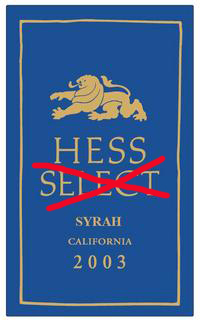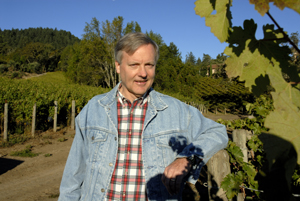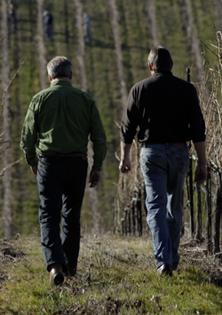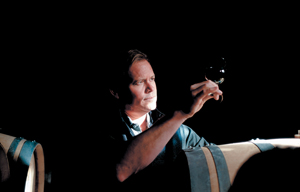

The elimination of the Hess Select line of generic wines has redirected the energy of the Hess Collection.
Mount Veeder ~ Napa Valley (AVA)
THE HESS ULTIMATUM
An interview with Hess Collection winemaker Dave Guffy reveals how the winery figured out a way to bolster their sagging image: Drop “Select” from labels, and move to single-vineyard, appellation designated wines.
by
Alan Goldfarb
August 10, 2007
ALAN GOLDFARB (AG): I see that lots of changes have taken place at Hess since Tom Selfridge took over as president. Tell me about some of them.
DAVE GUFFY (DG): We took a hard look at what we were doing. We looked to Tom. It’s always good to have an outside perspective on things. [Note: Selfridge headed the Chalone Group before he came to Hess.] He said we weren’t looking at the full potential. (He suggested) we recognize our Monterey program. He was also confused about Hess Select and Hess Collection wines.
AG: What do you mean by full potential?
DG: I’m not sure. My guess is that we sold ourselves short by calling it “California” wine (a heretofore all-encompassing appellation on the labels as opposed to narrowing the designations). Anytime you can go to a specific appellation, why wouldn’t you? We had our reasons in the old days (such as) former marketing regimes… (Vineyard- and/or AVA-designation) gives you more identity.
AG: What else did you do?
DG: We took a look at the word “Select” (which was the brand name for those California wines) and decided to drop it.
We have some plans with our red wines with the 2006 version, and we are going to make Cabernet Sauvignon from Mendocino, Lake, and Napa -
Tom Selfridge, President of the Hess Collection, looks over the Mount Veeder vineyard.what used to be called Hess Select. We own every vineyard that we work with in Napa. I have the farming under my direction, which is very important as a winemaker. … The way we farm is crucial to the way it ends up in the winery.
AG: Why Mendocino?
DG: We’re bullish on Mendocino. There are fantastic vineyards up there. There’s an assortment of old-vine vineyards that a lot of wineries departed from.
AG: Why did they leave those vineyards?
DG: For reasons they will have to tell you. (Maybe) they’re going cheaper. We’re going in the other direction, we’re trading up. … We’re continuing to go to Mendocino so as not to dilute our quality.
AG: What are those wines going to be called?
 DG: Select. {Laughs] No, it’s hard to not say Hess Select. It’s going to be our appellation series. We’re getting to more specific appellations, and recognizing them, as I said.
DG: Select. {Laughs] No, it’s hard to not say Hess Select. It’s going to be our appellation series. We’re getting to more specific appellations, and recognizing them, as I said.
AG: So, do you think Hess lost something when the “Select” wines became so prominent?
DG: I don’t think we lost anything through the years. … When we developed the “Select” wines, which became extremely successful but were not sourced from Napa Valley, we realized that with the purchase of these single- vineyard sources, it was time we continued to focus on (our) Napa Valley (wines).
AG: Didn’t the same thing happen at Hess that happened at Mondavi? Bob Mondavi told me in December of 2002 – before the sale to Constellation – that since they were concentrating on Woodbridge and not on Oakville, “we lost our image.”
DG: I don’t think so at all. We’ve always been known as making value wine and it’s been important to the winery. … But we live in Napa, we work in Napa, we make our wines in Napa. This is what we’re about and we’re going to continue to focus there. At the end of the day, we agree that appellations are important and anytime you have an appellation, you should recognize it. It puts the consumer at ease as to where the grapes are coming from and (gives) a consistency if they know it’s the same source.
AG: So, then tell me about your Napa Valley vineyards.
DG: In the mid-‘90s we purchased Su’ Skol. After working with it, we felt comfortable to lock ourselves up in the confines of that vineyard. (22,000 cases of Chardonnay priced at $25 will come from that southern Napa vineyard.)
AG: What does the vineyard give you?
DG: It’s a quarter-mile from San Francisco Bay, with extremely cool climate, perfect for Chardonnay. About 40 percent of the vineyard is from field selection clones brought in from other vineyards. We thought it had something special. The clones were not known but we found an exotic spice -- jasmine or honeysuckle -- not your run-of-the mill version of Napa Valley Chardonnay. … We think we have something special.
AG: What about the Allomi Vineyard? (This parcel is outside of the Howell Mountain AVA and near Pope Valley. About 25,000 of Cabernet Sauvignon will be produced, at $25 a bottle.)
DG: One of things that attracted us was to have a different source (of Cabernet). It’s the opposite of Mount Veeder. It has richer, deeper soil, it’s a much warmer condition than Mount Veeder, and it creates wine that’s more Napa Valley than Mount Veeder. It’s plush and fruit forward too but tends to have softer tannins for consuming early.
AG: Tell me about those Mount Veeder vineyards.
DG: We have been in a transition, a revolution (with those). Many blocks are in need of replanting. We’ve taken a
”Tom, I think this is just the beginning of a great relationship.”hard look at what has been done before and what worked and didn’t work. We’ve thrown the refractometers out the window. We taste for flavors now. We will never pick a whole block at once. There’s so much diversity up here: the angle to the sun, the soil difference between the top of the hill and bottom. Soil depths are different. And then there’s gravity. The lower portion generally sees more water. [Elevations in the four vineyards range from 600 to 2,000 feet.]
When we went to replant, we did something that we never did before. When we took out the Cabernet … we changed varieties in the middle of the row. For example, we went from Cab to Malbec. Cab is No. 1 but Malbec is extremely successful (up here) and then there’s Syrah, and Petit Verdot. My vineyard is not a good Cab Franc place, so, I’m replanting it to Malbec, and Vi
DAVE GUFFY (DG): We took a hard look at what we were doing. We looked to Tom. It’s always good to have an outside perspective on things. [Note: Selfridge headed the Chalone Group before he came to Hess.] He said we weren’t looking at the full potential. (He suggested) we recognize our Monterey program. He was also confused about Hess Select and Hess Collection wines.
AG: What do you mean by full potential?
DG: I’m not sure. My guess is that we sold ourselves short by calling it “California” wine (a heretofore all-encompassing appellation on the labels as opposed to narrowing the designations). Anytime you can go to a specific appellation, why wouldn’t you? We had our reasons in the old days (such as) former marketing regimes… (Vineyard- and/or AVA-designation) gives you more identity.
AG: What else did you do?
DG: We took a look at the word “Select” (which was the brand name for those California wines) and decided to drop it.
We have some plans with our red wines with the 2006 version, and we are going to make Cabernet Sauvignon from Mendocino, Lake, and Napa -

Tom Selfridge, President of the Hess Collection, looks over the Mount Veeder vineyard.
AG: Why Mendocino?
DG: We’re bullish on Mendocino. There are fantastic vineyards up there. There’s an assortment of old-vine vineyards that a lot of wineries departed from.
AG: Why did they leave those vineyards?
DG: For reasons they will have to tell you. (Maybe) they’re going cheaper. We’re going in the other direction, we’re trading up. … We’re continuing to go to Mendocino so as not to dilute our quality.
AG: What are those wines going to be called?
 DG: Select. {Laughs] No, it’s hard to not say Hess Select. It’s going to be our appellation series. We’re getting to more specific appellations, and recognizing them, as I said.
DG: Select. {Laughs] No, it’s hard to not say Hess Select. It’s going to be our appellation series. We’re getting to more specific appellations, and recognizing them, as I said.
AG: So, do you think Hess lost something when the “Select” wines became so prominent?
DG: I don’t think we lost anything through the years. … When we developed the “Select” wines, which became extremely successful but were not sourced from Napa Valley, we realized that with the purchase of these single- vineyard sources, it was time we continued to focus on (our) Napa Valley (wines).
AG: Didn’t the same thing happen at Hess that happened at Mondavi? Bob Mondavi told me in December of 2002 – before the sale to Constellation – that since they were concentrating on Woodbridge and not on Oakville, “we lost our image.”
DG: I don’t think so at all. We’ve always been known as making value wine and it’s been important to the winery. … But we live in Napa, we work in Napa, we make our wines in Napa. This is what we’re about and we’re going to continue to focus there. At the end of the day, we agree that appellations are important and anytime you have an appellation, you should recognize it. It puts the consumer at ease as to where the grapes are coming from and (gives) a consistency if they know it’s the same source.
AG: So, then tell me about your Napa Valley vineyards.
DG: In the mid-‘90s we purchased Su’ Skol. After working with it, we felt comfortable to lock ourselves up in the confines of that vineyard. (22,000 cases of Chardonnay priced at $25 will come from that southern Napa vineyard.)
AG: What does the vineyard give you?
DG: It’s a quarter-mile from San Francisco Bay, with extremely cool climate, perfect for Chardonnay. About 40 percent of the vineyard is from field selection clones brought in from other vineyards. We thought it had something special. The clones were not known but we found an exotic spice -- jasmine or honeysuckle -- not your run-of-the mill version of Napa Valley Chardonnay. … We think we have something special.
AG: What about the Allomi Vineyard? (This parcel is outside of the Howell Mountain AVA and near Pope Valley. About 25,000 of Cabernet Sauvignon will be produced, at $25 a bottle.)
DG: One of things that attracted us was to have a different source (of Cabernet). It’s the opposite of Mount Veeder. It has richer, deeper soil, it’s a much warmer condition than Mount Veeder, and it creates wine that’s more Napa Valley than Mount Veeder. It’s plush and fruit forward too but tends to have softer tannins for consuming early.
AG: Tell me about those Mount Veeder vineyards.
DG: We have been in a transition, a revolution (with those). Many blocks are in need of replanting. We’ve taken a

”Tom, I think this is just the beginning of a great relationship.”
When we went to replant, we did something that we never did before. When we took out the Cabernet … we changed varieties in the middle of the row. For example, we went from Cab to Malbec. Cab is No. 1 but Malbec is extremely successful (up here) and then there’s Syrah, and Petit Verdot. My vineyard is not a good Cab Franc place, so, I’m replanting it to Malbec, and Vi











 READER FEEDBACK: To post your comments on this story,
READER FEEDBACK: To post your comments on this story,


